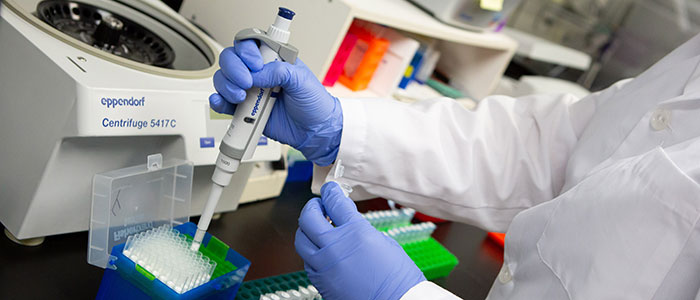ESU’s Dr. Jane Huffman Wildlife Genetics Institute Becomes the Center of Lyme Disease Testing/Research for PA

Posted by: admin on October 20, 2020, No Comments
For nearly a decade, Pennsylvania has been leading the U.S. in the number of reported Lyme disease cases per year with the number of confirmed cases across the Commonwealth rising from 6,017 in 2013 to 10,208 in 2018. What some may not know is that ticks are the common carriers of Lyme disease (particularly blacklegged ticks known as Ixodes scapularis). However, East Stroudsburg University’s Dr. Jane Huffman Wildlife Genetics Institute has been at the forefront of Lyme Disease testing and research for more than 15 years and has become headquarters for testing, monitoring, and reporting tick-borne infectious disease throughout the Northeast. As a matter of fact, ESU launched the PA Tick Research Laboratory in 2019, thanks to a $500,000 grant from the Commonwealth of Pennsylvania Department of Human Services that was supported by State Representative Rosemary Brown in order to support free tick testing services for all Pennsylvania residents.
Since the launch of the program in April 2019, PA’s Tick Research Lab has received and tested more than 18,000 ticks across the Commonwealth, representing all 67 counties. The free tick testing offer continues today to all residents of Pennsylvania based on a grant from the Commonwealth of Pennsylvania Department of Health in 2020, also secured by State Representative Brown. According to the Lab’s director, Nicole Chinnici, counties in Northeast Pennsylvania with the highest percentage of ticks testing positive for a tick-borne disease include Susquehanna – 55%, Luzerne – 47%, Wayne – 46% and Lackawanna – 44%. In the Pocono Mountains region, Monroe had 40%, Pike County 39%, and Carbon 36%. On average, Lyme disease is detected in 37% of Pennsylvania’s ticks and can spike as high as 67% in some counties. The significance of this program has allowed for county-level tracking of tick-borne illnesses which can be found at ticklab.org/statistics (see accompanying table for Lyme Disease statistics across Pennsylvania).
Pennsylvanians who find a tick on themselves, their loved ones or pets don’t need to panic. To submit a tick for testing, please visit www.ticklab.org/test-my-tick. In addition to the tick testing, the PA Tick Research Laboratory also provides residents with up-to-date educational materials aimed at assisting residents in the prevention of tick bites and tick-borne illnesses. State funding has allowed the lab to launch a state-wide campaign for spreading awareness for tick prevention, tick-borne illnesses, and other tick educational information. Individuals may sign up for prevention tips and weekly activity reports, available on Facebook, Instagram and Twitter, at @PATickLab.
Lastly, as Pennsylvanians continue to practice social distancing from one another to minimize risk of exposure to COVID-19, Chinnici suggests that residents also need to take precautions to avoid Lyme disease. As the signs of fall reveal themselves in the Poconos, residents and visitors need to be aware that October and November are high-volume tick months. Fall months are important for treating your yards to reduce the number of ticks that will be encountered in the spring. More information about protecting property can be found at ticklab.org/blog.
Percent of Ticks Testing Positive for a Tickborne Illness in PA
Total Ticks Tested = 10,310, July 1 2019 – June 30, 2020
| County | Percent Testing Positive |
|---|---|
| Adams | 25% |
| Allegheny | 42% |
| Armstrong | 54% |
| Beaver | 36% |
| Bedford | 36% |
| Berks | 35% |
| Blair | 54% |
| Bradford | 46% |
| Bucks | 24% |
| Butler | 48% |
| Cambria | 56% |
| Cameron | 67% |
| Carbon | 36% |
| Centre | 51% |
| Chester | 33% |
| Clarion | 52% |
| Clearfield | 54% |
| Clinton | 46% |
| Columbia | 59% |
| Crawford | 49% |
| Cumberland | 33% |
| Dauphin | 32% |
| Delaware | 28% |
| Elk | 58% |
| Erie | 56% |
| Fayette | 48% |
| Forest | 57% |
| Franklin | 25% |
| Fulton | 33% |
| Greene | 67% |
| Huntingdon | 45% |
| Indiana | 49% |
| Jefferson | 49% |
| Juniata | 35% |
| Lackawanna | 44% |
| Lancaster | 34% |
| Lawrence | 41% |
| Lebanon | 32% |
| Lehigh | 41% |
| Luzerne | 47% |
| Lycoming | 52% |
| McKean | 57% |
| Mercer | 40% |
| Mifflin | 33% |
| Monroe | 40% |
| Montgomery | 27% |
| Montour | 50% |
| Northampton | 34% |
| Northumberland | 50% |
| Perry | 40% |
| Philadelphia | 39% |
| Pike | 39% |
| Potter | 57% |
| Schuylkill | 39% |
| Snyder | 36% |
| Somerset | 51% |
| Sullivan | 47% |
| Susquehanna | 55% |
| Tioga | 51% |
| Union | 45% |
| Venango | 67% |
| Warren | 55% |
| Washington | 33% |
| Wayne | 46% |
| Westmoreland | 48% |
| Wyoming | 41% |
| York | 35% |




